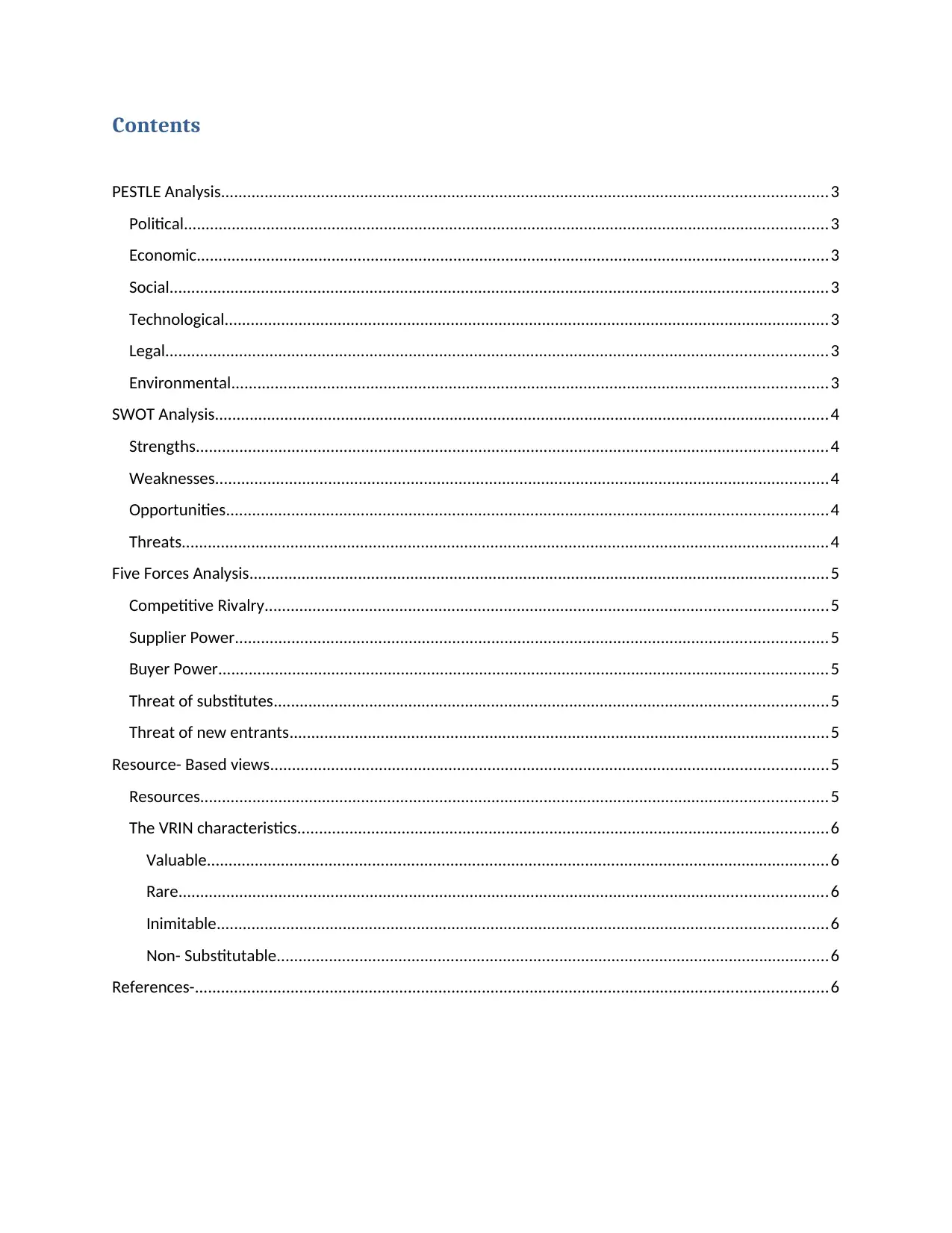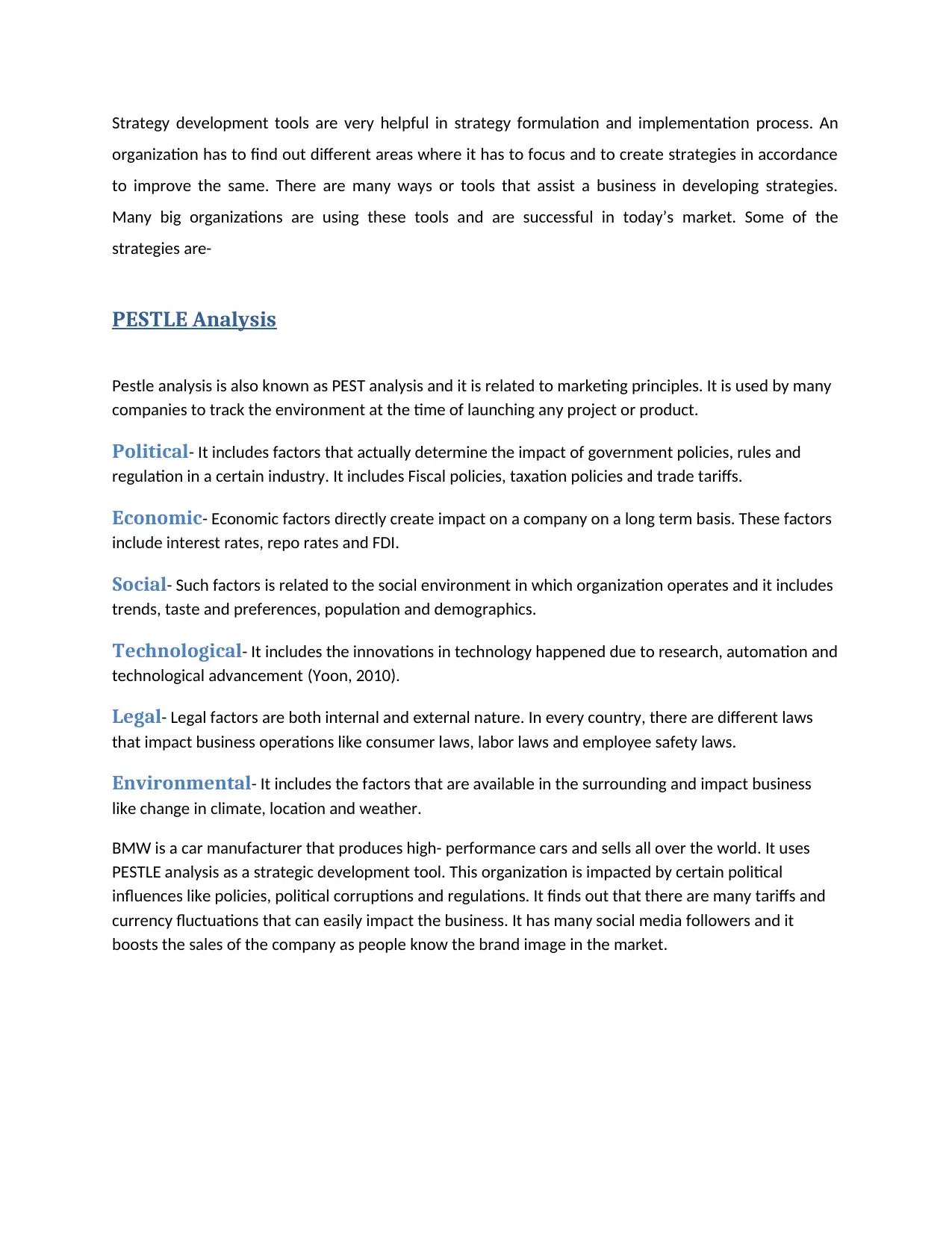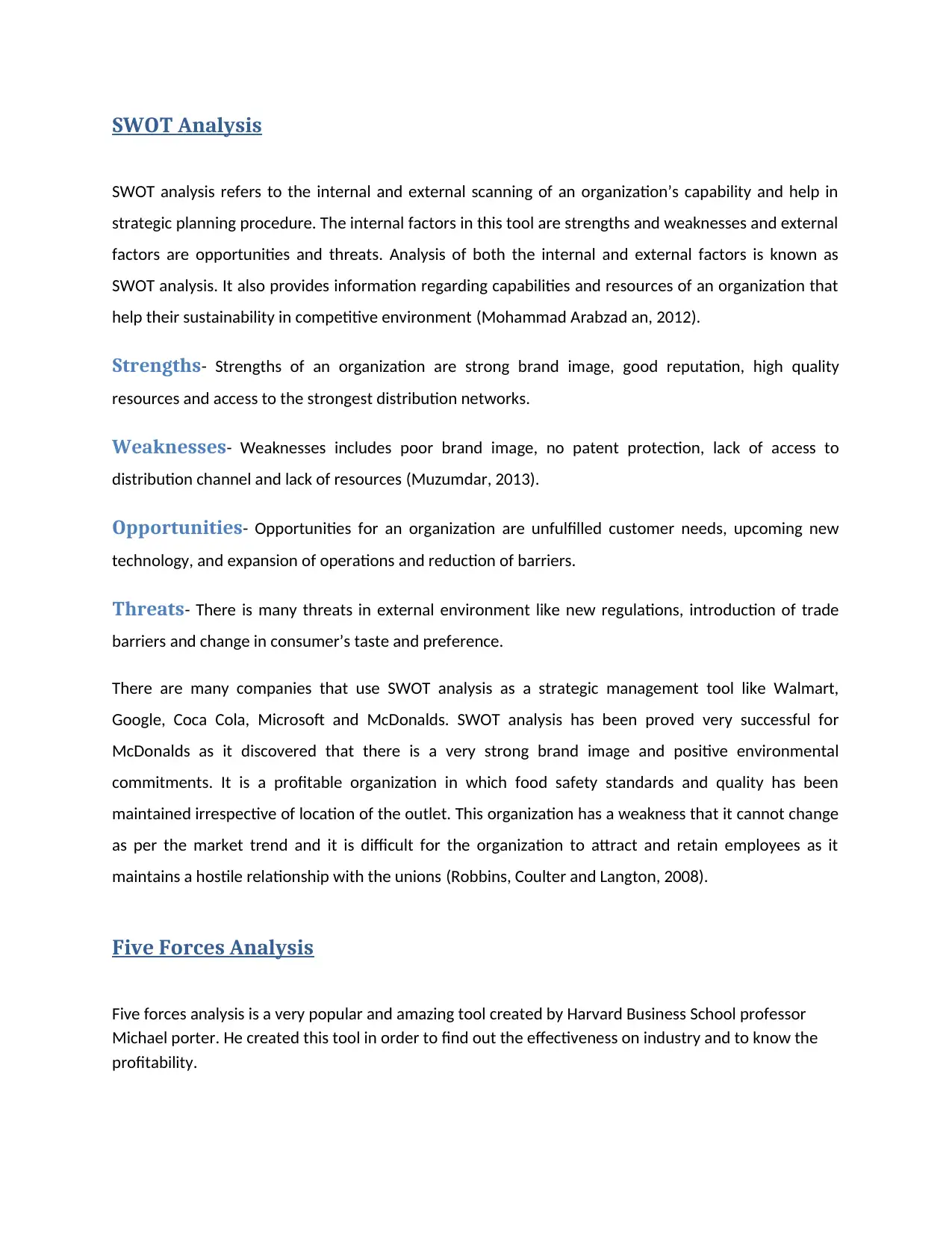Competitive Strategy Analysis: Applying Strategic Tools and Frameworks
VerifiedAdded on 2023/02/01
|7
|1597
|20
Report
AI Summary
This report provides a comprehensive overview of competitive strategy, exploring several key analytical tools and frameworks. It begins with an explanation of PESTLE analysis, detailing its political, economic, social, technological, legal, and environmental factors. The report then delves into SWOT analysis, examining an organization's internal strengths and weaknesses, alongside external opportunities and threats. Following this, the Five Forces analysis is discussed, outlining the dynamics of competitive rivalry, supplier power, buyer power, the threat of substitutes, and the threat of new entrants. Furthermore, the resource-based view is presented, emphasizing the importance of internal resources and the VRIN characteristics (valuable, rare, inimitable, and non-substitutable) for achieving a sustainable competitive advantage. The report uses examples of BMW and McDonald's to illustrate the application of these tools. Overall, the report offers a robust understanding of strategic analysis and its practical applications in business.

Competitive Strategy
Paraphrase This Document
Need a fresh take? Get an instant paraphrase of this document with our AI Paraphraser

Contents
PESTLE Analysis...........................................................................................................................................3
Political....................................................................................................................................................3
Economic.................................................................................................................................................3
Social.......................................................................................................................................................3
Technological...........................................................................................................................................3
Legal........................................................................................................................................................3
Environmental.........................................................................................................................................3
SWOT Analysis.............................................................................................................................................4
Strengths.................................................................................................................................................4
Weaknesses.............................................................................................................................................4
Opportunities..........................................................................................................................................4
Threats.....................................................................................................................................................4
Five Forces Analysis.....................................................................................................................................5
Competitive Rivalry.................................................................................................................................5
Supplier Power........................................................................................................................................5
Buyer Power............................................................................................................................................5
Threat of substitutes...............................................................................................................................5
Threat of new entrants............................................................................................................................5
Resource- Based views................................................................................................................................5
Resources................................................................................................................................................5
The VRIN characteristics..........................................................................................................................6
Valuable...............................................................................................................................................6
Rare.....................................................................................................................................................6
Inimitable............................................................................................................................................6
Non- Substitutable...............................................................................................................................6
References-.................................................................................................................................................6
PESTLE Analysis...........................................................................................................................................3
Political....................................................................................................................................................3
Economic.................................................................................................................................................3
Social.......................................................................................................................................................3
Technological...........................................................................................................................................3
Legal........................................................................................................................................................3
Environmental.........................................................................................................................................3
SWOT Analysis.............................................................................................................................................4
Strengths.................................................................................................................................................4
Weaknesses.............................................................................................................................................4
Opportunities..........................................................................................................................................4
Threats.....................................................................................................................................................4
Five Forces Analysis.....................................................................................................................................5
Competitive Rivalry.................................................................................................................................5
Supplier Power........................................................................................................................................5
Buyer Power............................................................................................................................................5
Threat of substitutes...............................................................................................................................5
Threat of new entrants............................................................................................................................5
Resource- Based views................................................................................................................................5
Resources................................................................................................................................................5
The VRIN characteristics..........................................................................................................................6
Valuable...............................................................................................................................................6
Rare.....................................................................................................................................................6
Inimitable............................................................................................................................................6
Non- Substitutable...............................................................................................................................6
References-.................................................................................................................................................6

Strategy development tools are very helpful in strategy formulation and implementation process. An
organization has to find out different areas where it has to focus and to create strategies in accordance
to improve the same. There are many ways or tools that assist a business in developing strategies.
Many big organizations are using these tools and are successful in today’s market. Some of the
strategies are-
PESTLE Analysis
Pestle analysis is also known as PEST analysis and it is related to marketing principles. It is used by many
companies to track the environment at the time of launching any project or product.
Political- It includes factors that actually determine the impact of government policies, rules and
regulation in a certain industry. It includes Fiscal policies, taxation policies and trade tariffs.
Economic- Economic factors directly create impact on a company on a long term basis. These factors
include interest rates, repo rates and FDI.
Social- Such factors is related to the social environment in which organization operates and it includes
trends, taste and preferences, population and demographics.
Technological- It includes the innovations in technology happened due to research, automation and
technological advancement (Yoon, 2010).
Legal- Legal factors are both internal and external nature. In every country, there are different laws
that impact business operations like consumer laws, labor laws and employee safety laws.
Environmental- It includes the factors that are available in the surrounding and impact business
like change in climate, location and weather.
BMW is a car manufacturer that produces high- performance cars and sells all over the world. It uses
PESTLE analysis as a strategic development tool. This organization is impacted by certain political
influences like policies, political corruptions and regulations. It finds out that there are many tariffs and
currency fluctuations that can easily impact the business. It has many social media followers and it
boosts the sales of the company as people know the brand image in the market.
organization has to find out different areas where it has to focus and to create strategies in accordance
to improve the same. There are many ways or tools that assist a business in developing strategies.
Many big organizations are using these tools and are successful in today’s market. Some of the
strategies are-
PESTLE Analysis
Pestle analysis is also known as PEST analysis and it is related to marketing principles. It is used by many
companies to track the environment at the time of launching any project or product.
Political- It includes factors that actually determine the impact of government policies, rules and
regulation in a certain industry. It includes Fiscal policies, taxation policies and trade tariffs.
Economic- Economic factors directly create impact on a company on a long term basis. These factors
include interest rates, repo rates and FDI.
Social- Such factors is related to the social environment in which organization operates and it includes
trends, taste and preferences, population and demographics.
Technological- It includes the innovations in technology happened due to research, automation and
technological advancement (Yoon, 2010).
Legal- Legal factors are both internal and external nature. In every country, there are different laws
that impact business operations like consumer laws, labor laws and employee safety laws.
Environmental- It includes the factors that are available in the surrounding and impact business
like change in climate, location and weather.
BMW is a car manufacturer that produces high- performance cars and sells all over the world. It uses
PESTLE analysis as a strategic development tool. This organization is impacted by certain political
influences like policies, political corruptions and regulations. It finds out that there are many tariffs and
currency fluctuations that can easily impact the business. It has many social media followers and it
boosts the sales of the company as people know the brand image in the market.
⊘ This is a preview!⊘
Do you want full access?
Subscribe today to unlock all pages.

Trusted by 1+ million students worldwide

SWOT Analysis
SWOT analysis refers to the internal and external scanning of an organization’s capability and help in
strategic planning procedure. The internal factors in this tool are strengths and weaknesses and external
factors are opportunities and threats. Analysis of both the internal and external factors is known as
SWOT analysis. It also provides information regarding capabilities and resources of an organization that
help their sustainability in competitive environment (Mohammad Arabzad an, 2012).
Strengths- Strengths of an organization are strong brand image, good reputation, high quality
resources and access to the strongest distribution networks.
Weaknesses- Weaknesses includes poor brand image, no patent protection, lack of access to
distribution channel and lack of resources (Muzumdar, 2013).
Opportunities- Opportunities for an organization are unfulfilled customer needs, upcoming new
technology, and expansion of operations and reduction of barriers.
Threats- There is many threats in external environment like new regulations, introduction of trade
barriers and change in consumer’s taste and preference.
There are many companies that use SWOT analysis as a strategic management tool like Walmart,
Google, Coca Cola, Microsoft and McDonalds. SWOT analysis has been proved very successful for
McDonalds as it discovered that there is a very strong brand image and positive environmental
commitments. It is a profitable organization in which food safety standards and quality has been
maintained irrespective of location of the outlet. This organization has a weakness that it cannot change
as per the market trend and it is difficult for the organization to attract and retain employees as it
maintains a hostile relationship with the unions (Robbins, Coulter and Langton, 2008).
Five Forces Analysis
Five forces analysis is a very popular and amazing tool created by Harvard Business School professor
Michael porter. He created this tool in order to find out the effectiveness on industry and to know the
profitability.
SWOT analysis refers to the internal and external scanning of an organization’s capability and help in
strategic planning procedure. The internal factors in this tool are strengths and weaknesses and external
factors are opportunities and threats. Analysis of both the internal and external factors is known as
SWOT analysis. It also provides information regarding capabilities and resources of an organization that
help their sustainability in competitive environment (Mohammad Arabzad an, 2012).
Strengths- Strengths of an organization are strong brand image, good reputation, high quality
resources and access to the strongest distribution networks.
Weaknesses- Weaknesses includes poor brand image, no patent protection, lack of access to
distribution channel and lack of resources (Muzumdar, 2013).
Opportunities- Opportunities for an organization are unfulfilled customer needs, upcoming new
technology, and expansion of operations and reduction of barriers.
Threats- There is many threats in external environment like new regulations, introduction of trade
barriers and change in consumer’s taste and preference.
There are many companies that use SWOT analysis as a strategic management tool like Walmart,
Google, Coca Cola, Microsoft and McDonalds. SWOT analysis has been proved very successful for
McDonalds as it discovered that there is a very strong brand image and positive environmental
commitments. It is a profitable organization in which food safety standards and quality has been
maintained irrespective of location of the outlet. This organization has a weakness that it cannot change
as per the market trend and it is difficult for the organization to attract and retain employees as it
maintains a hostile relationship with the unions (Robbins, Coulter and Langton, 2008).
Five Forces Analysis
Five forces analysis is a very popular and amazing tool created by Harvard Business School professor
Michael porter. He created this tool in order to find out the effectiveness on industry and to know the
profitability.
Paraphrase This Document
Need a fresh take? Get an instant paraphrase of this document with our AI Paraphraser

Competitive Rivalry- It includes the number of existing competitors in the market. It also shows
the impact of those competitors on suppliers and buyers. High competition in the market creates impact
on business policies (Önören, Arar and Yurdakul, 2017).
Supplier Power- Supplier power means the strengths or power to make changes in the supplier’s
prices. It includes the number of potential suppliers the organization have. If there are a high number of
suppliers in the market then it becomes easy for the organization to choose the cheaper one.
Buyer Power- It includes the power of buyers like at which level buyer can fluctuate the prices in the
organization. A small number of customers lead to high power with the customers.
Threat of substitutes- It means the number of substitute products available in the organization as
it can weaken the organization’s position in the market (Aigner, 2014).
Threat of new entrants- If there are so many new entrants in the market than it can impact the
position of existing organizations because new entrants come up with new technology and new offers.
McDonald’s has used Five forces analysis and experienced that there is a very high impact of external
factors on high intensities, because of the variations happen among markets all over the world
(Grebenshchikova and Yakushev, 2017).
Resource- Based views
Resource based views is a method of viewing a firm and then create strategy according to the same. It
assumes that a firm is a bundle of different resources and when these resources are combined, it
reflects the firm. The starting of this analysis has been done with the internal environment analysis. It
adopts an inside-out approach.
Resources
In this tool, resources refer to the assets, processes, capabilities, knowledge, attributes and knowledge.
Resources are considered as an input that assists the organization in performing the activities. There is
much type of resources that an organization uses, some of them possess strategic relevance and some
do not. There are a few resources that are actually able to create value and give a competitive
advantage to the organization. There are four qualities that an organization’s resources should have to
get competitive advantage.
The VRIN characteristics
the impact of those competitors on suppliers and buyers. High competition in the market creates impact
on business policies (Önören, Arar and Yurdakul, 2017).
Supplier Power- Supplier power means the strengths or power to make changes in the supplier’s
prices. It includes the number of potential suppliers the organization have. If there are a high number of
suppliers in the market then it becomes easy for the organization to choose the cheaper one.
Buyer Power- It includes the power of buyers like at which level buyer can fluctuate the prices in the
organization. A small number of customers lead to high power with the customers.
Threat of substitutes- It means the number of substitute products available in the organization as
it can weaken the organization’s position in the market (Aigner, 2014).
Threat of new entrants- If there are so many new entrants in the market than it can impact the
position of existing organizations because new entrants come up with new technology and new offers.
McDonald’s has used Five forces analysis and experienced that there is a very high impact of external
factors on high intensities, because of the variations happen among markets all over the world
(Grebenshchikova and Yakushev, 2017).
Resource- Based views
Resource based views is a method of viewing a firm and then create strategy according to the same. It
assumes that a firm is a bundle of different resources and when these resources are combined, it
reflects the firm. The starting of this analysis has been done with the internal environment analysis. It
adopts an inside-out approach.
Resources
In this tool, resources refer to the assets, processes, capabilities, knowledge, attributes and knowledge.
Resources are considered as an input that assists the organization in performing the activities. There is
much type of resources that an organization uses, some of them possess strategic relevance and some
do not. There are a few resources that are actually able to create value and give a competitive
advantage to the organization. There are four qualities that an organization’s resources should have to
get competitive advantage.
The VRIN characteristics

Valuable- The resources must be valuable to the organization so that it can provide competitive
advantage.
Rare- There must be uniqueness in resources because only in such cases they are able to provide
competitive advantage in comparison to other firms.
Inimitable- Resources can result in sustained competitive advantage if competitive firms do not
possess them. If the resources are available in competitor’s firm also then they can’t provide any kind of
competitive advantage (Tassabehji and Isherwood, 2014).
Non- Substitutable- There should be no substitute of the resources and they can’t be strategically
equivalent. If there are two different resources and both of them provide same advantage to different
firms then they are strategically equivalent. Such resources are not capable of providing competitive
advantage.
advantage.
Rare- There must be uniqueness in resources because only in such cases they are able to provide
competitive advantage in comparison to other firms.
Inimitable- Resources can result in sustained competitive advantage if competitive firms do not
possess them. If the resources are available in competitor’s firm also then they can’t provide any kind of
competitive advantage (Tassabehji and Isherwood, 2014).
Non- Substitutable- There should be no substitute of the resources and they can’t be strategically
equivalent. If there are two different resources and both of them provide same advantage to different
firms then they are strategically equivalent. Such resources are not capable of providing competitive
advantage.
⊘ This is a preview!⊘
Do you want full access?
Subscribe today to unlock all pages.

Trusted by 1+ million students worldwide

References-
Aigner, P. (2014). Ethnic Diversity Management In Theory And Practice. Journal of Diversity Management
(JDM), 9(2), p.111.
Grebenshchikova, L. and Yakushev, N. (2017). Definition of Competitiveness of the Enterprise Using the
Five Forces of M. Porter. Bulletin of Kalashnikov ISTU, 20(3), p.51.
Mohammad Arabzad an, S. (2012). Improving Project Management Process in Municipality Based on
SWOT Analysis. International Journal of Engineering and Technology, 4(5), pp.607-612.
Muzumdar, P. (2013). Business Model Development Through Corporate Strategy Design: IBM SWOT
Analysis. SSRN Electronic Journal.
Robbins, S., Coulter, M. and Langton, N. (2008). Management. Toronto: Pearson Prentice Hall.
Tassabehji, R. and Isherwood, A. (2014). Management Use of Strategic Tools for Innovating During
Turbulent Times. Strategic Change, 23(1-2), pp.63-80.
Yoon, B. (2010). Strategic visualisation tools for managing technological information. Technology Analysis
& Strategic Management, 22(3), pp.377-397.
Önören, M., Arar, T. and Yurdakul, G. (2017). Developing Competitive Strategies Based on SWOT Analysis
in Porter s Five Forces Model by DANP. Journal of Business Research - Turk, 9(2), pp.511-528.
Aigner, P. (2014). Ethnic Diversity Management In Theory And Practice. Journal of Diversity Management
(JDM), 9(2), p.111.
Grebenshchikova, L. and Yakushev, N. (2017). Definition of Competitiveness of the Enterprise Using the
Five Forces of M. Porter. Bulletin of Kalashnikov ISTU, 20(3), p.51.
Mohammad Arabzad an, S. (2012). Improving Project Management Process in Municipality Based on
SWOT Analysis. International Journal of Engineering and Technology, 4(5), pp.607-612.
Muzumdar, P. (2013). Business Model Development Through Corporate Strategy Design: IBM SWOT
Analysis. SSRN Electronic Journal.
Robbins, S., Coulter, M. and Langton, N. (2008). Management. Toronto: Pearson Prentice Hall.
Tassabehji, R. and Isherwood, A. (2014). Management Use of Strategic Tools for Innovating During
Turbulent Times. Strategic Change, 23(1-2), pp.63-80.
Yoon, B. (2010). Strategic visualisation tools for managing technological information. Technology Analysis
& Strategic Management, 22(3), pp.377-397.
Önören, M., Arar, T. and Yurdakul, G. (2017). Developing Competitive Strategies Based on SWOT Analysis
in Porter s Five Forces Model by DANP. Journal of Business Research - Turk, 9(2), pp.511-528.
1 out of 7
Related Documents
Your All-in-One AI-Powered Toolkit for Academic Success.
+13062052269
info@desklib.com
Available 24*7 on WhatsApp / Email
![[object Object]](/_next/static/media/star-bottom.7253800d.svg)
Unlock your academic potential
Copyright © 2020–2025 A2Z Services. All Rights Reserved. Developed and managed by ZUCOL.





